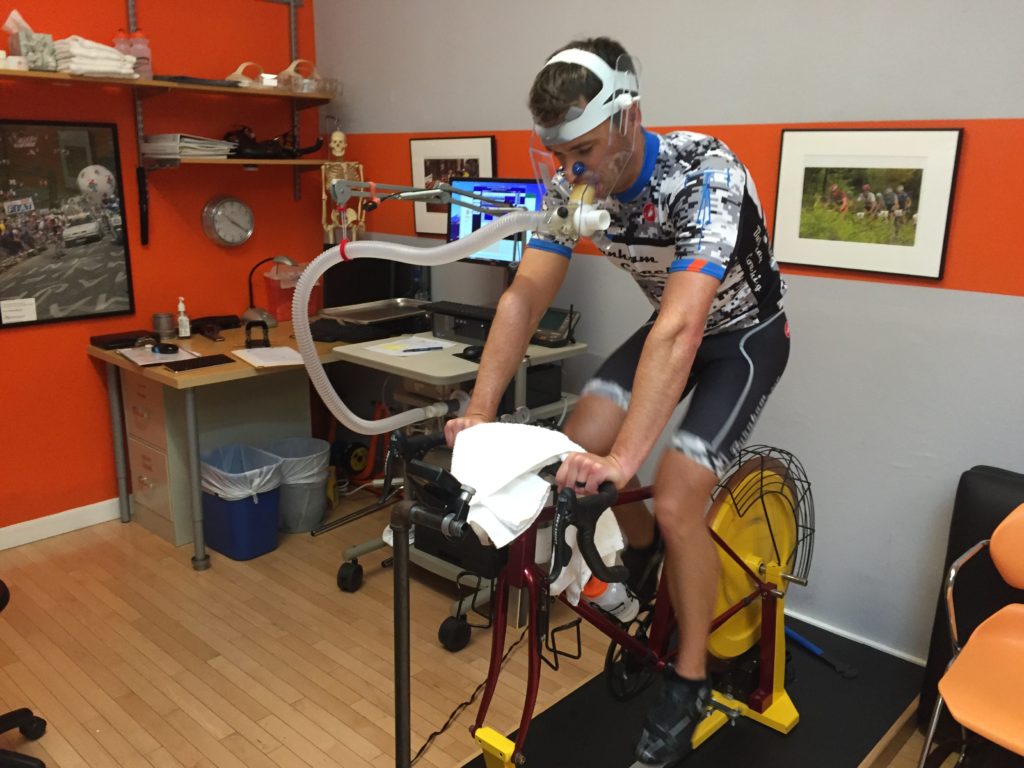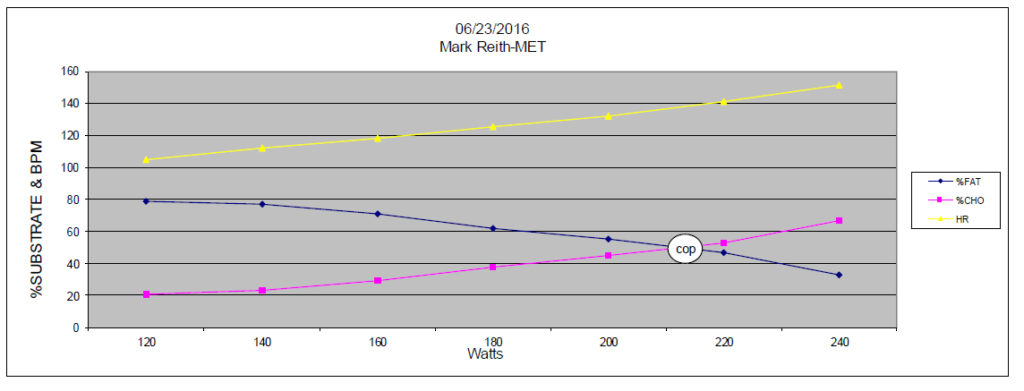I’ve wanted to do metabolic efficiency testing for a long time. I think you can play around with your nutrition and really dial it in, but it’s always nice to have some more exact measurements to better define and guide your own n=1 experiments. I personally just like to look at data, and if anything, use it as a learning experience and a form of continuing education for myself.
Endurance PTC is really the closest place around that has the equipment for a Metabolic Efficiency Test (MET). This past week, I drove to Mill Valley for a couple hours of testing with them. Here are the results of those tests.
Body Composition
The first thing I did with Tim at Endurance PTC was a body composition test. I thought this was going to be a little more scientific, but it’s really just the old-school skin caliper test. He tested my skin fold thickness at 3 different spots on my body (multiple readings at the same locations): belly, thigh, and ribs. The results, 12.5% body fat. That’s a bit higher than my Withings scale tells me every day (it says 8.5%). I secretly wanted to be under 10%, but I’m not sure if these numbers actually have any meaning for me in terms of performance. I don’t think you can say that if you went from 12% body fat to 10%, you will be a better athlete. In general, it seems better to be lower, but for me, it may not be the case. I think the more important thing here is to track changes and not the value itself. I don’t anticipate going in and doing skin caliper tests often, so I don’t think this was a super insightful test outside of reminding me I need to be aware of all the dessert I enjoy so much.
Sweat Test
Endurance PTC also offers Precision Hydration sweat tests. I thought this would be very applicable to my performance as I’ve always struggled with hydration due to my extreme sweat rate. The more I understand about sweat rate and sodium depletion, they better endurance athlete I think I can be. I really feel like a major limiting factor in my training and racing is the amount of fluid I lose from sweat.
The Precision Hydration sweat tests are pretty interesting. They put 2 quarter-size disks on your forearm with a chemical on them that makes that part of your skin sweat. Then they add an electric current, which you can’t really feel, to that disc to push the chemical into your skin to start the sweating on that area. Then they remove the discs, and collect the sweat on your skin and run that sweat through a machine which analyzes the sodium content of the sweat. You can see the process here. The idea is that the sodium content of your sweat does not vary much as your sweat rate increases or decreases. You always lose about the same amount of sodium per volume unit of sweat across all different sweat rates.
I had done the Levelen sweat test previously, which seems much less accurate, and had put my sodium loss at 1400mg per Liter of sweat. This Precision Hydration sweat test put my sodium loss at 1024mg per Liter of sweat. So this looks like I lose a little less sodium than I previously thought. This may explain why I looked like a bloated pig after my last race. Good to know. Now I can better plan my sodium intake during long training days and races.
Metabolic Testing
The last, and most time consuming test, was the Metabolic Efficiency Test. Tim at Endurance PTC looked me up to the Respiratory Gas Exchange system while on a stationary bike. This machine measures the amount of Oxygen I breathe in and the amount of CO2 I breathe out while riding the bike. The ratio of CO2 eliminated to O2 consumed is the Respiratory Quotient (RQ). This is a way to measure metabolism to see what I’m “burning” at different exercise intensities. An RQ of 1 is pure carbohydrate (sugar) metabolism, where a RQ of .7 is pure fat metabolism. My goal was to see how much fat and carbohydrate I burn when I am out riding. The ultimate goal here is to train your body through nutrition and training to be better at burning fat and to burn more fat at higher intensities.
The test was designed to start me at 120 watts on the bike and step me up by 20 watts every 5 minutes until 240 watts. This would give me a range of sub-max power outputs on the bike applicable to the types of races I do. I will say, it’s pretty uncomfortable to have your nose pinned and breath through a tube on a trainer up to 240 watts. Very do-able, but very awkward. 
Here are the results:
I was secretly worried that I was a huge sugar burner. Most people who know me, know I have no concept of moderation when it comes to dessert. So, while I’m pretty picky about the quality of the dessert, I pretty much will demolish all sugar put in front of me (especially if it’s homemade with love). So I was pleasantly happy that I was still able to burn a good amount of fat at higher intensities.
My cross over point, where I burn equal sugar and fat is around 210-215 watts. This is about Ironman pacing on the bike.
My Fatmax point, where I am the best fat burner (if I wanted to burn lots of fat) is 160 watts, which is pedaling fairly easy. So if I wanted to burn off all that ice cream which converted to fat, I’d be better off going out and doing a very easy bike ride than going out and doing a hard ride.
I think this data is going to be very useful for planning out my nutrition strategy for long races, like Ironman. I think I can probably get away with consuming less calories from sugar than I previously thought, looking at this data.
Another interesting take away is that my Metabolic Efficiency Zone, where I am the most metabolic efficient (more fat burning) is 140-180 watts. In theory, I should be spending a lot of time in this zone training, where I would be “teaching” my body to be a better and more efficient fat burner. The reality is I never train this low on the bike. So maybe I need to slow down my easy rides. This also probably means, I should slow down my easy endurance runs, as I assume this data would translate over to running as well.
Overall, I got a lot of good data from these tests and I’m glad I did it. I think this data will guide more trial and error testing on my own in terms of training and nutrition.


